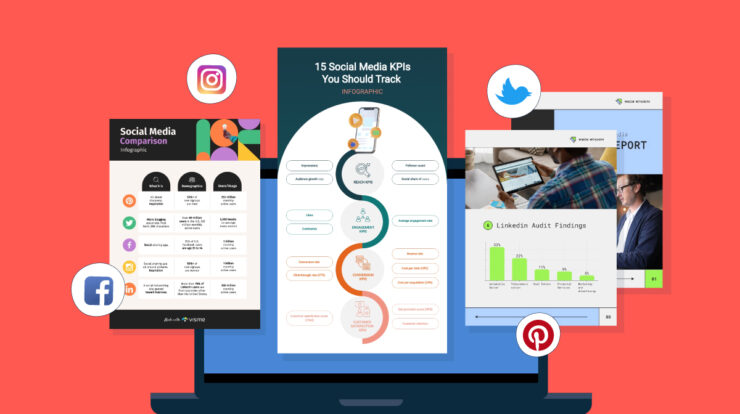Social media has become an integral part of marketing for businesses in today’s digital age. With billions of people using social media platforms like Facebook, Instagram, Twitter, and LinkedIn, it provides an excellent opportunity for businesses to reach out to their target audience and grow their business. Here are some effective social media strategies that can help businesses grow:
● Develop a social media plan

Developing a social media plan is an important step in creating a successful social media strategy for your business. Your goals might include increasing brand awareness, driving traffic to your website, generating leads, or building customer loyalty.
Identify your ideal customers, including their demographics, interests, and behaviors. This will help to compare content with needs and preferences. Choose the social media platforms that are most relevant to your target audience and your goals (for e.g. Facebook, Twitter, LinkedIn, Instagram, and YouTube)
It is very important to create a plan for the type of content you will post, how often you will post, and when you will post. Your content should be informative and relevant according to your target audience.
Decide on the budget you will allocate to social media marketing, including paid advertising and other expenses. Assign roles and responsibilities for managing your social media accounts, including content creation, scheduling, and monitoring.
And last but not the least: regularly review and adjust your social media plan based on the performance data you collect. This will help you optimize your strategy and achieve your goals more effectively.
● Create high-quality content

High-quality content can help you to attract and retain customers by providing them with valuable information, insights, and resources. It is all about building trust and establishing your business as a thought leader in your industry. Creating high-quality content that is shareable and valuable can help to increase your brand’s visibility and reach on social media and other online channels (to attract new customers and grow your audience).
● Engage with your audience
Social media is a two-way conversation. Respond to comments, messages, and posts from your followers. This helps build a relationship with your audience and increases engagement.
● Use paid social media advertising
Social media platforms offer a range of advertising options that can help businesses reach a larger audience. Use paid ads to target specific locations and increase visibility.
● Leverage influencers
In general, it can help businesses reach a fresh audience and build credibility. Identify relevant influencers in your industry and collaborate with them to promote your brand. Influencer marketing has become an increasingly popular strategy for businesses of all sizes. By partnering with influencers who have a strong social media following and a loyal fan base, businesses can tap into a wider audience and benefit from the trust and authority that these influencers have already established with their followers. In addition, influencer marketing can help businesses increase their social media engagement, generate more leads, and ultimately drive sales. To maximize the benefits of influencer marketing, it’s important to carefully identify the right influencers for your brand and work with them to create content that resonates with their audience and aligns with your marketing goals.
● Monitor and measure your success
Use analytics tools to monitor your social media efforts and its success. This allows you to measure the impact of your strategies and adjust accordingly.
By following these social media strategies, businesses can effectively leverage social media to grow their brand and reach their target audience.
How to raise funds for projects or ventures from a large number of people through the internet?

Crowdfunding software development refers to the creation and implementation of a software platform that enables entrepreneurs, artists, and other individuals to raise funds for their projects or ventures from a large number of people through the internet. https://itexus.com/crowdfunding-software-development-core-players-features-business-model/
Crowdfunding software typically includes a range of features that help individuals or businesses to create a crowdfunding campaign, promote it, and collect payments from backers. The software may include features such as campaign management, social media integration, payment processing, and analytics.
There are several types of crowdfunding models, such as donation-based, debt-based, equity-based, and reward-based crowdfunding. The type of crowdfunding model used will determine the specific features and functionality needed in the software.
Crowdfunding software development typically involves a team of developers, designers, and project managers who work together to create a platform that meets the needs of the client and their target audience. The software may be built from scratch, or it may be based on existing open-source platforms that are customized to meet specific requirements.
Crowdfunding software development can be a complex and challenging process that requires a deep understanding of crowdfunding models, payment processing, and user experience design. However, with the right team and approach, it can result in a powerful platform that helps entrepreneurs and other individuals to bring their ideas to life.
Some features for Crowdfunding Software

- Campaign management:
A crowdfunding platform should offer easy-to-use tools for creating and managing campaigns, including setting funding goals, creating campaign pages, and tracking progress.
- Payment processing
The platform should provide secure and reliable payment processing options that support multiple payment methods and currencies.
- Social media integration
The platform should enable campaigners to easily share their campaigns on social media and other online channels to increase visibility and reach.
- Backer management
The platform should provide tools for managing and communicating with backers, including sending updates, fulfilling rewards, and issuing refunds if necessary.
- Analytics and reporting
The platform should offer detailed analytics and reporting features to help campaigners track campaign performance, identify trends, and make data-driven decisions.
- Customization options
The platform should offer customization options that allow campaigners to create unique and engaging campaign pages, including multimedia content such as images and videos.
- Security and fraud prevention
The platform should have robust security measures in place to prevent fraud and protect the privacy and personal information of campaigners and backers.
- Mobile optimization
The platform should be optimized for mobile devices to ensure that campaigners and backers can access and participate in campaigns from anywhere.
- Support and documentation
The platform should provide comprehensive documentation, tutorials, and customer support to help campaigners and backers navigate the platform and resolve any issues.
By including these must-have features, crowdfunding software can provide a powerful and effective way for businesses and individuals to raise funds and achieve their goals.
Related Posts:
- Mastering Instagram Marketing: Guide to Success
- 20 Best Gaming Headset Under 50$ 2024 - for PC, PS4,…
- 15 Best Dog Food For Allergies 2024 - Adult, Puppy…
- Top 10 Best Dog Nail Grinder 2024 - Best Care for Your Pet
- Top 10 Best Power Inverter for Car 2024 - Keep Your…
- Top 5 Digital Marketing Solutions To Make Your Business Grow







